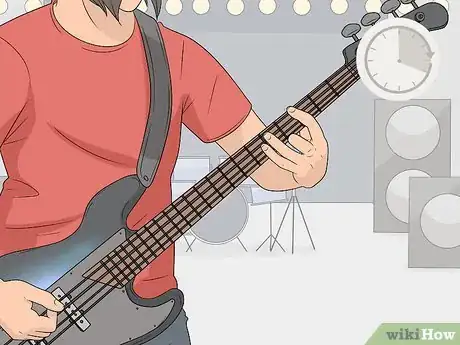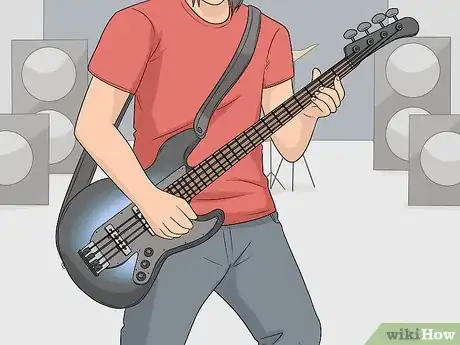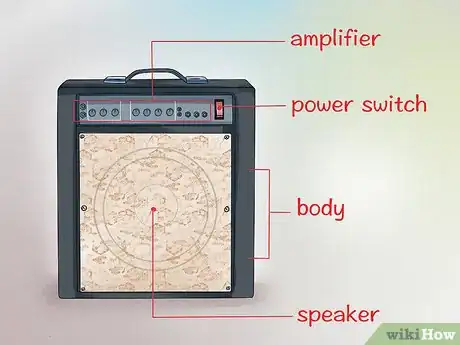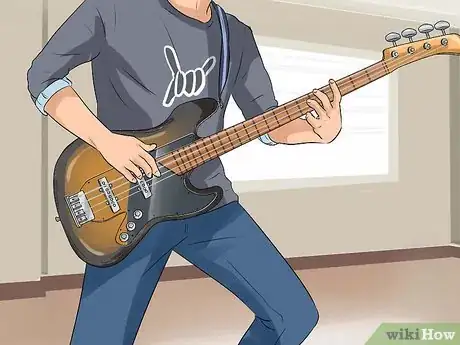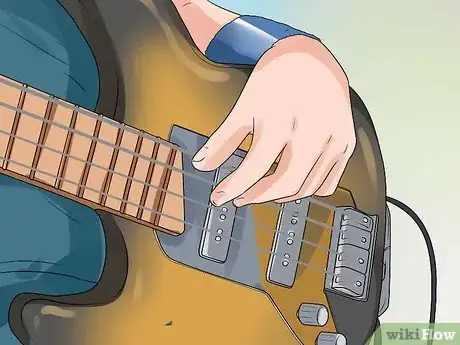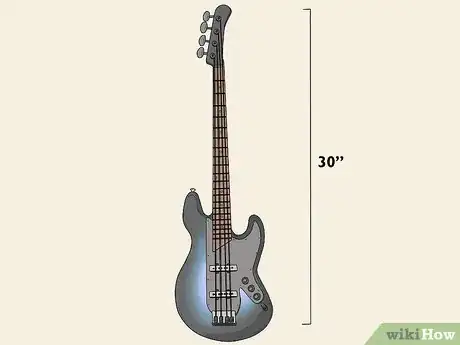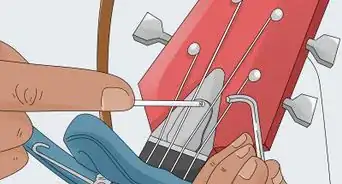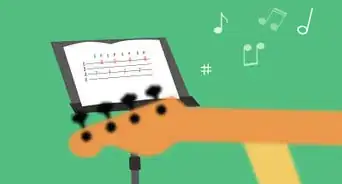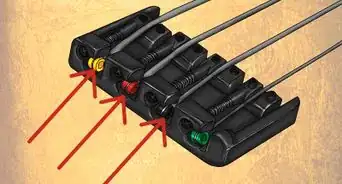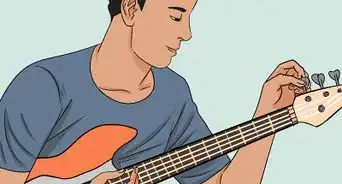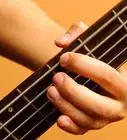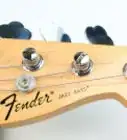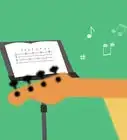This article was co-authored by Nicolas Adams and by wikiHow staff writer, Jennifer Mueller, JD. Nicolas Adams is a 5th generation musician of Serbian Gypsy descent and the lead guitarist of the band Gypsy Tribe. Based in the San Francisco Bay Area, Nicolas specializes in Rumba Flamenco and Gypsy jazz and playing the guitar, Bouzouki, Balalaika, and piano.
There are 16 references cited in this article, which can be found at the bottom of the page.
wikiHow marks an article as reader-approved once it receives enough positive feedback. This article received 38 testimonials and 100% of readers who voted found it helpful, earning it our reader-approved status.
This article has been viewed 849,686 times.
While an experienced instructor can help tremendously, it is possible to teach yourself to play bass guitar. Take some time to get used to the instrument, even if you already know how to play guitar. Have patience, and recognize that learning a new instrument will take time and effort. If you set aside time each day to work with your bass, you'll be jamming out new licks in no time.[1]
Steps
Practicing
-
1Focus on chord tones and patterns to start. The chord tones are the first note (the "root")' the third and the fifth. In the key of C Major, the root, third and fifth are the notes C, E and G. In some types of music, you may play the flatted seventh. In the key of C Major, the flatted seventh is B flat. Most bass lines are composed of outlines of chord tones. Pick a chord to practice each week, and play the chord tones. Once you're comfortable with the chord tones, figure out how the chord fits into a scale and you can practice creating a short bass line.[2]
- Drilling arpeggios (the first, third and fifth note of a chord, often also going up to the octave of the root) is a good way to start practicing bass and learn the fundamentals that go into strong, supportive bass lines. Start slow, and gradually up the tempo.
EXPERT TIPNicolas Adams is a 5th generation musician of Serbian Gypsy descent and the lead guitarist of the band Gypsy Tribe. Based in the San Francisco Bay Area, Nicolas specializes in Rumba Flamenco and Gypsy jazz and playing the guitar, Bouzouki, Balalaika, and piano.Professional Guitarist
 Nicolas Adams
Nicolas Adams
Professional GuitaristRemember that a bass guitar uses a different string set than a regular guitar. On a 4-string bass guitar, your lowest string (in pitch) is an E. On a 5-string bass guitar, it's a B, so when you're first learning, you have to really focus on that so you don't lose your place. You also have to practice different structural patterns as you play the notes. The bass isn't just an accompany instrument—if you can master it, it can be a solo instrument, as well.
-
2Mute strings to keep the sound clean. A bass line is made up of individual notes played cleanly. If a string keeps vibrating, the sound bleeds over into the next note. Mute strings below the note you're playing with your plucking hand. Use your fretting hand to mute the strings above the note you're playing.[3]
- With every note, you want only one string to ring out while you mute the other three.
- It takes a lot of practice to coordinate your hands properly to mute all the strings you're not playing. Go slowly and have patience. Expect to get frustrated at first. Just keep at it, and it will eventually click.
Advertisement -
3Use a metronome to maintain rhythm. In a band, the bass serves as a bridge between the drummer and the guitarists. As a member of the rhythm section of the band, you have to be able to stay in time. When you're just getting started, a metronome can help you.[4]
- Eventually you'll need to keep tempo without relying on a metronome – especially if you plan to perform live. Train your ear to recognize different tempos. When you're playing with a drummer, synchronize your playing with theirs.
-
4To add interest to your basslines, try hammer-ons and pull-offs to play more notes in sequence. Pluck a string, and while the note is still ringing, press your finger further down the string to play a higher note without plucking. Pull-offs work the opposite way. Pluck the string to play a higher note, then pull off a finger to play a lower note.[5]
- Pull-offs are generally a little more difficult than hammer-ons. When you're just starting, you may want to pluck the string lightly as you pull off your finger to make sure the second note rings out.
- With practice, you can use hammer-ons and pull-offs together to create quicker and more complicated bass lines.
-
5Play with tabulature notation ("tabs") if you want to learn songs quickly. A bass tab shows the four strings of the bass drawn horizontally. The lowest (thickest) string is always at the bottom of the tab, the highest (thinnest) string is at the top. Notes are indicated by the number of the fret on the string where the note should be played.[6]
- If you don't know how to read standard music notation, tabs enable you to start playing songs almost immediately. This can increase your confidence as you develop your ability as a bass player.
- You can find tabs for most popular songs online. Look for beginner tabs, which are more simplified versions.
-
6Learn music notation and theory to advance your ability. Even if you've learned how to read music in connection with playing the guitar, reading bass music is a little different. The notes for a bass guitar are on the bass clef, with the lines and spaces representing different notes.[7]
- You can remember the names of the notes on the bass clef's lines and spaces with a mnemonic (memory aid). The most common mnemonics are "Good Boys Do Fine Always" for the lines (from the lowest line to the highest), and "All Cows Eat Grass" for the spaces (from the lowest space to the highest). Feel free to create your own mnemonic if you can come up with something that's easier for you to remember.
- If you only want to learn to play a little bass to entertain your family and friends or jam with pals, learning music notation may not be the best use of your time. However, if you want to play bass for a living, it's a sound investment.
-
7Try to warm up for at least 20 minutes before playing. After gently stretching your wrists and forearms, play some arpeggios or go through a familiar bass line. Play slowly, allowing your fingers to get accustomed to the movement.[8]
- If you plan to play for several hours, you may want to have a longer warm up. If your forearms and wrists feel sore after playing, try a longer warm-up period next time you play.
- You can also use the warm-up time to tune your bass or check for any problems.
-
8Set aside time each day for your instrument. You can't teach yourself to play bass without putting time into it. If you don't work on something bass-related every day, you run the risk of forgetting what you've learned, causing your progress to stagnate.[9]
- Your time doesn't have to be devoted exclusively to playing your bass. You can also spend time reading books about music, as well as watching concert videos or listening to songs that include some of your favorite bassists.
- When you watch other bassists for the purpose of practice, note their posture and hand positions. Get your bass guitar out and try to mimic them as they play.
Getting Comfortable
-
1Set up your amplifier. Setting up the amplifier for your bass is similar to setting up an electric guitar amplifier. Plug the amp into the wall, then turn down the volume and gain before you plug your bass in.[10]
- For most bass amps, turn up the gain to between 10 o'clock and 1 o'clock. Experiment until you get a sound you like. Gain is similar to volume, but controls the volume of your bass coming into the pre-amp. Adjusting the gain changes the tone of your instrument.
- Generally, set the EQ between 500-800Hz for the best tone control.
-
2Practice tuning your bass. The process of tuning your bass is similar to tuning a guitar or any other stringed instrument. On a 4-string bass, the strings themselves are tuned to E, A, D, and G. The E string is the lowest pitch, the G string is the highest. A bass is tuned one octave lower than a guitar.[11]
- Tuning by ear, using a guide note, will help you become more familiar with the tones. You can get guide notes from a piano or from a website that provides tuning notes. However, especially when you're first starting, a digital tuner will ensure you're fine-tuning your bass correctly.
-
3Sit and stand with proper posture. Holding the bass correctly and maintaining good posture is important both for playing and for preventing injuries. Forearm pain and carpal tunnel syndrome may develop if you develop poor playing habits.[12]
- Always use the strap when playing your bass while standing. The wider the strap, the more it distributes the weight of the instrument. Stand with your shoulders level, not hunched over the instrument.
- Ideally, when standing, your bass should be at about waist height, with the neck angled so the headstock is at about the height of your shoulders.
- When sitting, avoid resting the upper body or neck of the bass on your leg. Hold the neck up at an angle, and move your leg out of the way. Sit up straight with your shoulders back. If you're going to play sitting, choose a stool rather than a comfortable chair.
-
4Pluck with your index and middle fingers. For bass, your fingers are numbered but not your thumb. Your index finger is "1," your middle finger is "2," your ring finger is "3," and your pinky finger is "4." For speed and efficiency, most bassists pluck the strings by alternating between 1 and 2.[13]
- When plucking, keep your hand loose. Trim your nails short so they don't get caught on the strings as you play.
- If you want to play the bass with a pick, use a heavy gauge guitar pick. Hold the pick between your thumb and index finger, and strum the pick downward then up to "pluck" the string with the pick. You can also do repeated downstrokes for a heavier, more accented sound.
-
5Stretch and strengthen your forearms and wrists. Your wrists and forearms will definitely get a workout from extended bass playing. Strong, flexible forearms and wrists help you avoid injury or painful conditions, such as carpal tunnel syndrome.[14]
- One good exercise is to hold your arm out in front of you with your elbow straight and your palm facing up. Reach over with your other hand and gently pull your hand down until you feel a stretch. Hold for 10 to 15 seconds, then do the same exercise with your other hand. Repeat 3 times with each hand.
- If you pull down you also want to push back. Hold your arm out in front of you with your elbow straight and your palm facing down. Pull your palm back towards your body with your other hand, until you feel a stretch. Hold for 10 to 15 seconds, then do the same exercise with your other hand. Repeat 3 times with each hand.
- You also want to strengthen the fingers of your fretting hand. You can find single-string permutations online that will help with this.[15]
Choosing a Bass
-
1Familiarize yourself with a bass guitar's anatomy. Have a decent understanding of the parts of a bass guitar and how they function before you go out shopping for a bass guitar. This will help you find the best bass guitar that suits your interests and your budget.[16]
- Generally, you want a fretted instrument. Fretless basses are more suitable for experienced bass players who can rely on muscle memory and a well-rounded ear to play notes correctly.
- Basses may have either bolt-on necks, set necks, or thru-body necks. Bolt-on necks are the most common, and are found on less expensive instruments. This is generally the best choice for your first bass.
- A bass guitar may have 4, 5, or 6 strings. For the sake of simplicity, start with a 4-string bass. After you feel comfortable with a 4-string bass, you can always move on from there to a 5- or 6-string bass.
-
2Evaluate your budget. You want to buy the best quality instrument you can for your money. At the same time, you don't necessarily want to spend a lot of money on your first bass guitar. Look at beginner kits that include a bass, amp combo, and case.[17]
- You might also consider buying a used instrument. However, if you buy a used instrument you'll typically need to buy your own amp, tools, and other accessories.
-
3Try a short-scale bass if you have smaller hands. Scale is the length from the nut to the bridge. Most bass guitars are 34" scale. If you're younger, or have difficulty holding a full-size bass, there are smaller instruments available at 30" scale.[18]
- Short-scale bass guitars may be harder to find, and you may end up spending a little more to get a quality instrument.
-
4Pick a shape and color that you like. Bass guitars come in a variety of colors and body shapes. The shape and color have little to do with the way the bass sounds. Find something that feels comfortable in your hands.[19]
- If you buy a bass that you like looking at, it can help motivate you to play more.
- Check out the shapes and colors of the basses played by your favorite musicians to get some ideas of looks you like.
- Keep in mind that while shape and color have little to do with how the bass sounds, they can drastically affect the price – particularly for rare or custom designs.
-
5Look for a bass combo to simplify amplification. You'll need to plug your electric bass guitar into an amp to hear it. Bass amp combos are an all-in-one solution that include both the amplifier and the speaker in a single cabinet.[20]
- A combo unit is also a good idea if you're going to be traveling a lot with your bass, because you only have to move one thing.
- Some manufacturers sell beginner's bass kits that come with a bass amp combo. These can make your selection process easier, particularly if this is your first electric instrument.
Community Q&A
Did you know you can get answers researched by wikiHow Staff?
Unlock staff-researched answers by supporting wikiHow
-
QuestionHow do I know the key and the progression of the song?
 wikiHow Staff EditorThis answer was written by one of our trained team of researchers who validated it for accuracy and comprehensiveness.
wikiHow Staff EditorThis answer was written by one of our trained team of researchers who validated it for accuracy and comprehensiveness.
Staff Answer wikiHow Staff EditorStaff AnswerIf you can read music, the key signature will be at the beginning of each line. If you can't read music, look for the tonic note. This is the first note of the scale, and will sound right virtually anywhere in the song. Play notes on a keyboard or other instrument as you play or sing the song. Listen and use trial and error until you find one that works. That will tell you the key.
wikiHow Staff EditorStaff AnswerIf you can read music, the key signature will be at the beginning of each line. If you can't read music, look for the tonic note. This is the first note of the scale, and will sound right virtually anywhere in the song. Play notes on a keyboard or other instrument as you play or sing the song. Listen and use trial and error until you find one that works. That will tell you the key. -
QuestionMy fingers are so small so it hurts when I try to play. What to do? :(
 wikiHow Staff EditorThis answer was written by one of our trained team of researchers who validated it for accuracy and comprehensiveness.
wikiHow Staff EditorThis answer was written by one of our trained team of researchers who validated it for accuracy and comprehensiveness.
Staff Answer wikiHow Staff EditorStaff Answer
wikiHow Staff EditorStaff Answer -
QuestionHow can my fingers be fast on the fret board?
 Community AnswerJust by practice. Set a pattern of different notes and try to hit them one by one, slowly at first, then faster and faster. The more natural it becomes, the more quickly you'll play.
Community AnswerJust by practice. Set a pattern of different notes and try to hit them one by one, slowly at first, then faster and faster. The more natural it becomes, the more quickly you'll play.
References
- ↑ https://www.studybass.com/lessons/basics/mistakes-beginners-make/
- ↑ https://www.studybass.com/lessons/bass-chord-patterns/chord-tones-are-primary/
- ↑ https://www.studybass.com/lessons/bass-technique/open-string-muting/
- ↑ https://www.musical-u.com/learn/bass-ear-training-how-to/
- ↑ https://www.studybass.com/lessons/bass-technique/pull-offs/
- ↑ https://takelessons.com/blog/how-to-play-bass-z01
- ↑ https://www.studybass.com/lessons/reading-music/pitch-notation/
- ↑ https://www.theguitarmagazine.com/features/john-myung-top-10-tips/
- ↑ https://www.theguitarmagazine.com/features/john-myung-top-10-tips/
- ↑ https://www.premierguitar.com/articles/Get_To_Know_Your_Bass_Amp_Part_2
- ↑ https://takelessons.com/blog/how-to-play-bass-z01
- ↑ https://www.studybass.com/lessons/bass-technique/holding-the-bass/
- ↑ https://www.studybass.com/lessons/bass-technique/plucking/
- ↑ https://www.bodybuilding.com/fun/5-exercises-to-prevent-wrist-injuries.html
- ↑ https://www.bassplayer.com/lessons/taming-your-fretting-hand-part-1
- ↑ https://thehub.musiciansfriend.com/bass-guitar-buying-guide/bass-guitar-buying-guide
- ↑ https://thehub.musiciansfriend.com/bass-guitar-buying-guide/bass-guitar-buying-guide
- ↑ https://thehub.musiciansfriend.com/bass-guitar-buying-guide/the-best-bass-guitars-for-beginners
- ↑ https://thehub.musiciansfriend.com/bass-guitar-buying-guide/bass-guitar-buying-guide
- ↑ https://thehub.musiciansfriend.com/bass-guitar-buying-guide/bass-amplifiers-how-to-choose-the-right-bass-amp-rig
About This Article
It might take a lot of practice to teach yourself to play bass guitar, but if you practice every day, you can do it! When you’re first getting started, pick a chord to practice each week. During that week, focus on playing chord tones, which are the foundation of most bass lines. If you want to learn new songs quickly, look up the bass tabs online. The lowest, or thickest, string is always at the bottom of the tap, while the highest, or thinnest, string will be at the top. The notes are indicated by the number of the fret on the string where the note should be played. For tips on choosing and tuning your bass guitar, read on!






